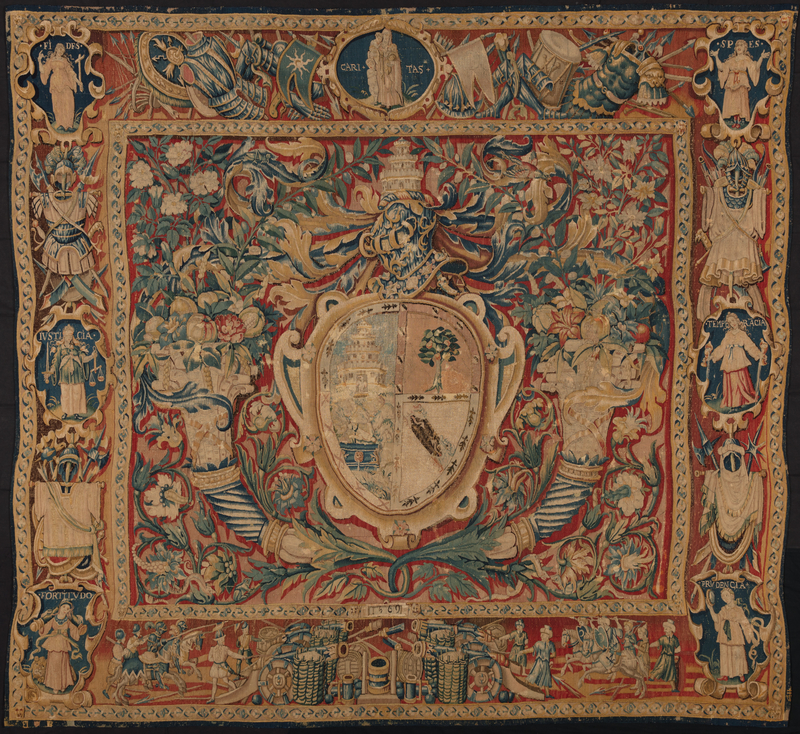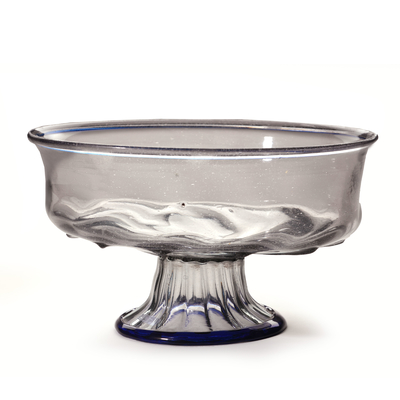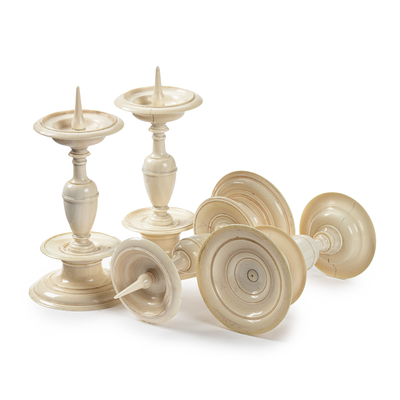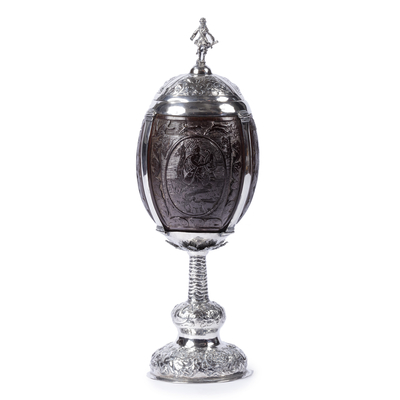Flemish armorial tapestry
Global shipping available
- Origin
- Brussels
- Period
- 1560
- Material
- Wool and silk
- Signature
- W. Pannemaker 1560
- Height
- 275 cm
- Width
- 250 cm
- Literature
T. P. Campbell, ‘How Medieval and Renaissance Tapestries Were Made’ in: Heilbrunn Timeline of Art History, New York, The Metropolitan Museum of Art, 2008.
E. Roobaert, ‘Artistieke bedrijvigheid in het paleis op de Coudenberg te Brussel bij het bezoek van de koning en koningin van Bohemen in juli 1556’ in: Oud Holland, vol. 123, 2010, pp. 12 - 20.
Questions about this object?
Please use one of the contact options below:
Description
This exceptional woven tapestry has a coat of arms in the centre, with the seven virtues and various armouries at the edge. The tapestry is woven in the workshop of Willem de Pannemaker, an important Brussels tapestry weaver, who was active between 1535 and 1578. Pieter de Pannemaker, father of Willem de Pannemaker, was a weaver at the court of Margaret of Austria, and Willem was a royal supplier of various tapestries to the Habsburg princes and courtiers, including Mary of Hungary, Charles V, Philip II, Margaret of Parma, the Duke of Alva, and Cardinal Granvelle. Willem de Pannemaker produced for Mary of Hungary, among other works, the famous and costly tapestry series 'The Conquest of Tunis', about the conquest of the capital of Tunisia by Charles V, and for governor Juan de la Cerda the series 'The Wedding of Mercury', which depicts the myth of Mercury and Herse. These carpets were woven with the finest wool, gold and silver thread and silk, and are very expensive in both material and cost of labour.
In the centre of the tapestry is a coat of arms with shield and crown, presumably of Spanish origin. On the shield is a white castle, a tree with fruit, two dragons and an indistinct representation of a falling figure and a blue fountain. On top of the blue jeweled crown is the same castle as on the shield. The castle is perhaps a reference to the kingdom of Castile and the (pomegranate) tree to the kingdom of Granada. The dragons appear on various weapons of counts or knights from Granada. he edge of the shield is decorated with five flowers. Below the coat of arms are two horns of plenty, which extend from leafy vines into twisted horns with various flowers and fruit. The shield and the horns are on a red background with flowers and tendrils, between which various animals such as a frog, snake, bird, grasshopper and butterfly are hidden. Next to the shield, two olive branches bend upwards. A square garland of flowers frames the middle part of the carpet. Two ribbons swing around the alternating blue and white flowers. In the corners are four golden lion heads, with a ring through the nose. Below the shield, the year 1560 is inscribed in the border, with two lion heads next to it.
The seven virtues are depicted in medallions in the outer border. Above is Caritas, the personification of love and charity, depicted as a woman with three children around her. In the right-hand corner is Spes, the personification of hope. She holds her hands open in an expecting pose. In the centre right is Temperacia, the personification of self-control, holding a chalice with water in both hands. In the lower right corner is the Prudencia, the personification of prudence, holding her attributes, a mirror and a snake. In the lower left corner is the Fortitudo, the personification of courage, with a column on her shoulders, and a lion behind her. In the centre left is the blindfolded Justicia, the personification of justice, holding a double-edged sword and scales. In the top left corner is Fides, the personification of faith, with a cross in her hands. Between the seven virtues are six armouries, each representing a different army and its weaponry. At the bottom of the carpet, there is a battle, with a European army on one side, with knights on horseback, and the Ottoman army on the other. Between the fighting parties are fortifications and cannonballs. Both armies are about to fire the cannons. The half-moons on the shields of the Ottoman warriors are also found on the right-hand banner in the upper edge, next to the Caritas. The left-hand banner shows a sun on a blue background. Next to the banners, two armouries are lying on the ground, with spears, arrows, drum and shield. The armour and the Ottoman army depicted, in combination with the, presumably, Spanish coat of arms, may point to the battles in the sixteenth century between the Spanish and Ottoman empires. The outer border of the garment consists of the same garland of flowers as in the centre, surrounded by ribbons and with golden lion heads in the corners.
The production of carpets in the fifteenth and sixteenth centuries was mainly concentrated in the Southern Netherlands, with Brussels as the centre. Brussels became the epicentre of the carpet weaving industry through a combination of circumstances, in which the Burgundian court, which was located in Brussels, played a very important role. The court provided a constant flow of orders, for which competent weavers were needed. In addition, the St. Lukas guild, to which the weavers belonged, had a monopoly on the manufacture of figurative tapestries. These conditions attracted highly skilled weavers and led to the refinement and further development of the weaver's craft. This led to extraordinary technical and artistic achievements, of which the tapestries from the workshops of Pieter and Willem de Pannemaker were among the best.





